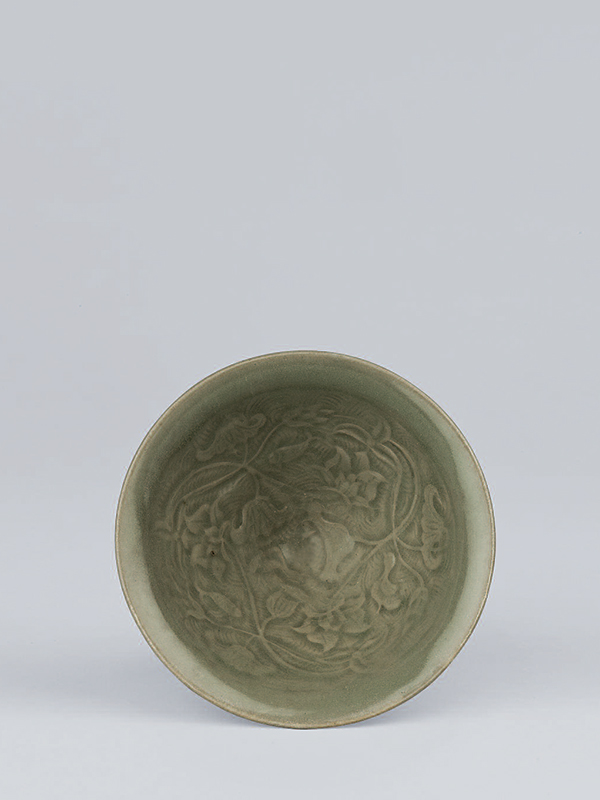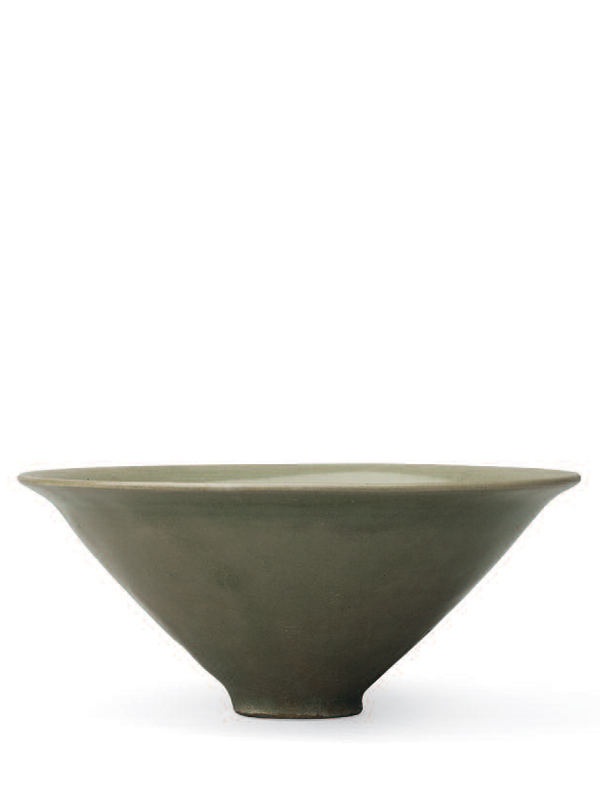Yaozhou stoneware bowl
A stoneware bowl of wide conical shape with a flared rim and a short, straight foot. The interior of the bowl is mould-impressed with a lotus pond scene, with lotus blossoms and leaves interspersed among elaborate tendrils, and two fish swimming through wavy water, which is engraved with a linear comb pattern. The exterior of the bowl is plain. The bowl is entirely covered in a lustrous translucent olive-green glaze, which pools to a slightly darker colour in the recesses. Small clusters of kiln grit adhere to the base.
This finely made stoneware bowl is characterised by fine, competent potting, which was executed on a wheel, after which the sides were thinned down using a special tool. During the Song period, the use of moulds to create a decorative pattern became commonplace.[1] The Chinese fascination for green-glazed high-fired wares goes back to the introduction of the earliest glazes and, in the case of yaozhou wares, continued well into the 14th century.[2] The lotus motif frequently appears in the early period.[3] A closely comparable Song dynasty yaozhou bowl impressed with a bunch of flowers and also engraved with a linear comb pattern, slightly smaller in size but similar in both the flared rim and the plain exterior, is in the collection of the Palace Museum, Beijing.[4] Another comparable yaozhou bowl with a design of ducks among waves, similar in size, the colour of the glaze and dated to the Northern Song dynasty, is in the collection of the Victoria and Albert Museum.[5] A third comparable Northern Song yaozhou bowl impressed with a decoration of four boys climbing plants, similar in size and shape, is in the Sir Alan Barlow collection in the Ashmolean Museum in Oxford.[6]
- Vainker, S.J. Chinese Pottery and Porcelain: From Prehistory to the Present, British Museum Press, London, 1991, p. 113
- Mino, Y. and Tsiang, K.R. Ice and Green Clouds, Traditions of Chinese Celadon, Indianapolis Museum of Art, 1986, p. 13
- Medley, M. The Chinese Potter: A Practical History of Chinese Ceramics, Phaidon, Oxford, 1976, p. 116
- Li, Huibing ed., Liang Song Ci Qi, vol.I Gugong bowuyuan cang wenwu zhenpin quaji, Shangwu yinshuguan, Hong Kong, no. 112, p. 126
- Kerr, R. Song Dynasty Ceramics, V&A Publications, London, 2004, nos. 51, 51a, p. 56
- Tregear, M. Song Ceramics, Thames and Hudson, London, 1982, no. 126, p. 108


